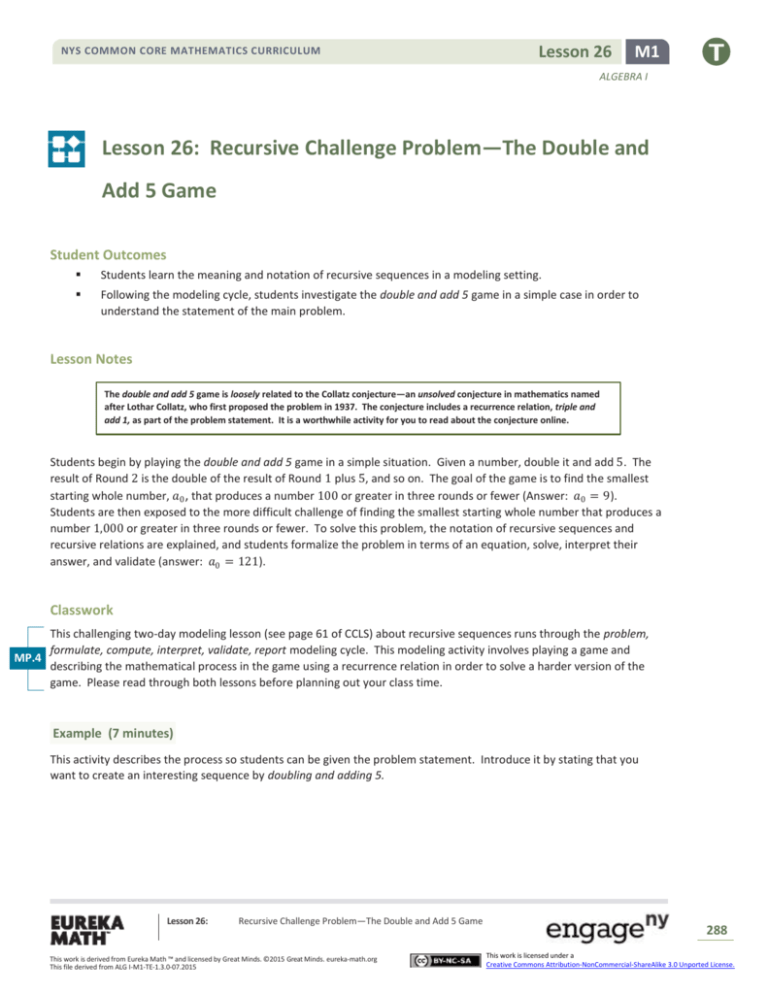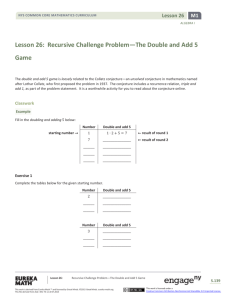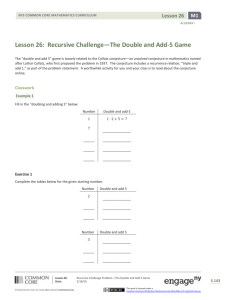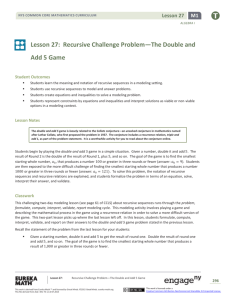Algebra I Module 1, Topic D, Lesson 26: Teacher Version
advertisement

NYS COMMON CORE MATHEMATICS CURRICULUM
Lesson 26
M1
ALGEBRA I
Lesson 26: Recursive Challenge Problem—The Double and
Add 5 Game
Student Outcomes
Students learn the meaning and notation of recursive sequences in a modeling setting.
Following the modeling cycle, students investigate the double and add 5 game in a simple case in order to
understand the statement of the main problem.
Lesson Notes
The double and add 5 game is loosely related to the Collatz conjecture—an unsolved conjecture in mathematics named
after Lothar Collatz, who first proposed the problem in 1937. The conjecture includes a recurrence relation, triple and
add 1, as part of the problem statement. It is a worthwhile activity for you to read about the conjecture online.
Students begin by playing the double and add 5 game in a simple situation. Given a number, double it and add 5. The
result of Round 2 is the double of the result of Round 1 plus 5, and so on. The goal of the game is to find the smallest
starting whole number, 𝑎0 , that produces a number 100 or greater in three rounds or fewer (Answer: 𝑎0 = 9).
Students are then exposed to the more difficult challenge of finding the smallest starting whole number that produces a
number 1,000 or greater in three rounds or fewer. To solve this problem, the notation of recursive sequences and
recursive relations are explained, and students formalize the problem in terms of an equation, solve, interpret their
answer, and validate (answer: 𝑎0 = 121).
Classwork
This challenging two-day modeling lesson (see page 61 of CCLS) about recursive sequences runs through the problem,
formulate, compute, interpret, validate, report modeling cycle. This modeling activity involves playing a game and
MP.4
describing the mathematical process in the game using a recurrence relation in order to solve a harder version of the
game. Please read through both lessons before planning out your class time.
Example (7 minutes)
This activity describes the process so students can be given the problem statement. Introduce it by stating that you
want to create an interesting sequence by doubling and adding 5.
Lesson 26:
Recursive Challenge Problem—The Double and Add 5 Game
This work is derived from Eureka Math ™ and licensed by Great Minds. ©2015 Great Minds. eureka-math.org
This file derived from ALG I-M1-TE-1.3.0-07.2015
288
This work is licensed under a
Creative Commons Attribution-NonCommercial-ShareAlike 3.0 Unported License.
Lesson 26
NYS COMMON CORE MATHEMATICS CURRICULUM
M1
ALGEBRA I
Work through the table below with your students on the board to explain the meaning of the following:
starting number,
double and add 5,
result of round one,
result of round two, and so on.
Here is what the table looks like at the beginning:
starting number →
Number
1
7
______
______
______
Double and add 5
1∙2+5= 7
7 ∙ 2 + 5 = 19
_______________
_______________
_______________
Number
Double and add 5
𝟏
𝟕
𝟏𝟗
𝟒𝟑
𝟗𝟏
𝟏∙𝟐+𝟓 =𝟕
𝟕 ∙ 𝟐 + 𝟓 = 𝟏𝟗
𝟏𝟗 ∙ 𝟐 + 𝟓 = 𝟒𝟑
𝟒𝟑 ∙ 𝟐 + 𝟓 = 𝟗𝟏
𝟗𝟏 ∙ 𝟐 + 𝟓 = 𝟏𝟖𝟕
← result of round 1
← result of round 2
and here is the completed table:
Example
Fill in the doubling and adding 𝟓 below:
starting number →
← result of round 1
← result of round 2
← result of round 3
← result of round 4
← result of round 5
Exercise 1 (5 minutes)
Have students complete the tables in Exercise 1. Walk around the classroom to ensure they are completing the tables
correctly and understand the process.
Exercise 1
Complete the tables below for the given starting number.
Number
𝟐
𝟗
𝟐𝟑
Double and add 5
𝟐∙𝟐+𝟓=𝟗
𝟗 ∙ 𝟐 + 𝟓 = 𝟐𝟑
𝟐𝟑 ∙ 𝟐 + 𝟓 = 𝟓𝟏
Number
𝟑
𝟏𝟏
𝟐𝟕
Double and add 5
𝟑 ∙ 𝟐 + 𝟓 = 𝟏𝟏
𝟏𝟏 ∙ 𝟐 + 𝟓 = 𝟐𝟕
𝟐𝟕 ∙ 𝟐 + 𝟓 = 𝟓𝟗
Lesson 26:
Recursive Challenge Problem—The Double and Add 5 Game
This work is derived from Eureka Math ™ and licensed by Great Minds. ©2015 Great Minds. eureka-math.org
This file derived from ALG I-M1-TE-1.3.0-07.2015
289
This work is licensed under a
Creative Commons Attribution-NonCommercial-ShareAlike 3.0 Unported License.
Lesson 26
NYS COMMON CORE MATHEMATICS CURRICULUM
M1
ALGEBRA I
Mathematical Modeling Exercise/Exercise 2 (15 minutes)
MP.1
(Problem statement of the modeling cycle.) State the following (starter) problem to students, and let them wrestle with
it until they find a solution (or at least a strategy for finding the solution):
Mathematical Modeling Exercise/Exercise 2
Given a starting number, double it and add 𝟓 to get the result of Round 1. Double the result of Round 1 and add 𝟓, and so
on. The goal of the game is to find the smallest starting whole number that produces a result of 𝟏𝟎𝟎 or greater in three
rounds or fewer.
Walk around the class, observe student work, and give advice, such as:
Does starting with 10 produce a result of 100 or greater in Round 3?
Yes.
Why will all numbers greater than 10 work? Can you find a smaller starting number that also works?
Do you see any patterns in the tables you have already created?
As the starting number increases by 1, the result of Round 3 increases by 8.
Yes, 9 works. Is it the smallest?
Yes. When I start with 8, I need four rounds to get past 100.
After 8 minutes, show (or have a student show) that 9 is the correct answer by showing the tables:
Number
𝟖
𝟐𝟏
𝟒𝟕
Double and add 5
𝟖 ∙ 𝟐 + 𝟓 = 𝟐𝟏
𝟐𝟏 ∙ 𝟐 + 𝟓 = 𝟒𝟕
𝟒𝟕 ∙ 𝟐 + 𝟓 = 𝟗𝟗, no.
Number
𝟗
𝟐𝟑
𝟓𝟏
Double and add 5
𝟗 ∙ 𝟐 + 𝟓 = 𝟐𝟑
𝟐𝟑 ∙ 𝟐 + 𝟓 = 𝟓𝟏
𝟓𝟏 ∙ 𝟐 + 𝟓 = 𝟏𝟎𝟕, yes.
Invite students to share other methods for finding the answer. For example, some may have worked the problem
backward: If 100 is reached in three rounds, then
100−5
2
= 47.5 must have been reached in two rounds, and
MP.1 47.5−5 = 21.25 must been reached after the first round, which means the starting number is greater than
2
21.25−5
2
= 8.125, or the whole number 9.
Tell students that the next goal is to solve the same problem, but find the smallest number that results in 1,000 in three
rounds or fewer:
Given a starting number, double it and add 5 to get the result of Round 1. Double the result of Round 1 and
add 5, and so on. The goal of the game is to find the smallest starting whole number that produces a result of
1,000 or greater in three rounds or fewer.
Lesson 26:
Recursive Challenge Problem—The Double and Add 5 Game
This work is derived from Eureka Math ™ and licensed by Great Minds. ©2015 Great Minds. eureka-math.org
This file derived from ALG I-M1-TE-1.3.0-07.2015
290
This work is licensed under a
Creative Commons Attribution-NonCommercial-ShareAlike 3.0 Unported License.
Lesson 26
NYS COMMON CORE MATHEMATICS CURRICULUM
M1
ALGEBRA I
This problem is not as easy as the starter problem to solve by guess-and-check. To solve this problem, guide students to
formulate an equation. But first, you will need to explain how mathematicians create and describe recursive sequences.
Let 𝑎1 be the number of the result of Round 1. We can also label the result of Round 2 as 𝑎2 , and so on. Ask, “How
could we label the starting number?” Guide them to label the starting number as 𝑎0 . Then write an equation in terms of
𝑎0 and 𝑎1 in the table (that is still on the board) like this:
Number
𝑎0 = 5
𝑎1 = 15
𝑎2 = 35
Double and add 5
5 ∙ 2 + 5 = 15
15 ∙ 2 + 5 = 35
35 ∙ 2 + 5 = 75
Equation
𝑎0 ∙ 2 + 5 = 𝑎1
_______________
_______________
Ask students to help you complete and extend the table as follows:
Number
𝑎0 = 5
𝑎1 = 15
𝑎2 = 35
𝑎3 = 75
______
𝑎𝑖
𝑎𝑖+1
Double and add 5
5 ∙ 2 + 5 = 15
15 ∙ 2 + 5 = 35
35 ∙ 2 + 5 = 75
_______________
_______________
_______________
_______________
Equation
𝑎0 ∙ 2 + 5 = 𝑎1
𝑎1 ∙ 2 + 5 = 𝑎2
𝑎2 ∙ 2 + 5 = 𝑎3
_______________
_______________
𝑎𝑖 ∙ 2 + 5 = 𝑎𝑖+1
_______________
Highlight on the board that the ordered list of terms 5, 15, 35, 75, … can be described by an initial value, 𝑎0 = 5, and a
recurrence relation, 𝑎𝑖+1 = 2𝑎𝑖 + 5, for 𝑖 ≥ 0. Written as follows:
𝑎 =5
{ 0
𝑎𝑖+1 = 2𝑎𝑖 + 5, 𝑖 ≥ 0
Tell them that this is an example of a recursively-defined sequence, or simply, a recursive sequence.
Have students mentally use the recurrence relation to find the next term after 75. Is it the double and add 5
rule?
What other terms have we studied so far that are defined recursively?
Ask:
Algebraic expressions, polynomial expressions, monomials
Teacher note: Terms that are defined recursively often use the term itself in the statement of the definition, but the
definition of the term is not considered circular. Circularity does not arise in recursively defined terms because they
always start with a well defined set of base examples, and then the definition describes how to generate new examples
of the term from those base examples, which, by reiterating further, can then be used to generate all other examples of
the term. The base examples prevent the definition from being circular. For recursive sequences, the base example(s) is
just the initial value(s). For algebraic expressions, the well defined base examples are numerical symbols and variable
symbols.
Lesson 26:
Recursive Challenge Problem—The Double and Add 5 Game
This work is derived from Eureka Math ™ and licensed by Great Minds. ©2015 Great Minds. eureka-math.org
This file derived from ALG I-M1-TE-1.3.0-07.2015
291
This work is licensed under a
Creative Commons Attribution-NonCommercial-ShareAlike 3.0 Unported License.
Lesson 26
NYS COMMON CORE MATHEMATICS CURRICULUM
M1
ALGEBRA I
Exercise 3 (10 minutes)
Ask students:
Exercise 3
Using a generic initial value, 𝒂𝟎 , and the recurrence relation, 𝒂𝒊+𝟏 = 𝟐𝒂𝒊 + 𝟓, for 𝒊 ≥ 𝟎, find a formula for 𝒂𝟏 , 𝒂𝟐 , 𝒂𝟑 , 𝒂𝟒
in terms of 𝒂𝟎 .
Let students work individually or in pairs. Visit each group and ask questions that lead students to the following:
𝒂𝟏
𝒂𝟐
𝒂𝟑
𝒂𝟒
= 𝟐𝒂𝟎 + 𝟓,
= 𝟐𝒂𝟏 + 𝟓 = 𝟐(𝟐𝒂𝟎 + 𝟓) + 𝟓 = 𝟒𝒂𝟎 + 𝟏𝟓,
= 𝟐𝒂𝟐 + 𝟓 = 𝟐(𝟐 ∙ 𝟐𝒂𝟎 + 𝟏𝟓) + 𝟓 = 𝟖𝒂𝟎 + 𝟑𝟓,
= 𝟐𝒂𝟑 + 𝟓 = 𝟐(𝟐𝟑 ∙ 𝒂𝟎 + 𝟑𝟓) + 𝟓 = 𝟏𝟔𝒂𝟎 + 𝟕𝟓.
Closing (5 minutes)
Discuss the following definitions in the student materials:
Vocabulary
SEQUENCE: A sequence can be thought of as an ordered list of elements. The elements of the list are called the terms of
the sequence.
For example, (P, O, O, L) is a sequence that is different than (L, O, O, P). Usually the terms are indexed (and therefore
ordered) by a subscript starting at either 𝟎 or 𝟏: 𝒂𝟏 , 𝒂𝟐 , 𝒂𝟑 , 𝒂𝟒 , …. The “…” symbol indicates that the pattern described
is regular, that is, the next term is 𝒂𝟓 , and the next is 𝒂𝟔 , and so on. In the first example, 𝒂𝟏 = 𝑷 is the first term, 𝒂𝟐 =
𝑶 is the second term, and so on. Both finite and infinite sequences exist everywhere in mathematics. For example, the
infinite decimal expansion of
𝟏
𝟑
= 𝟎. 𝟑𝟑𝟑𝟑𝟑𝟑𝟑𝟑𝟑… can be represented as the sequence
(𝟎. 𝟑, 𝟎. 𝟑𝟑, 𝟎. 𝟑𝟑𝟑, 𝟎. 𝟑𝟑𝟑𝟑, …).
RECURSIVE SEQUENCE: An example of a recursive sequence is a sequence that is defined by (1) specifying the values of one or
more initial terms and (2) having the property that the remaining terms satisfy a recurrence relation that describes the
value of a term based upon an algebraic expression in numbers, previous terms, or the index of the term.
The sequence generated by initial term, 𝒂𝟏 = 𝟑, and recurrence relation, 𝒂𝒏 = 𝟑𝒂𝒏−𝟏 , is the sequence
(𝟑, 𝟗, 𝟐𝟕, 𝟖𝟏, 𝟐𝟒𝟑, …). Another example, given by the initial terms, 𝒂𝟎 = 𝟏, 𝒂𝟏 = 𝟏, and recurrence relation, 𝒂𝒏 =
𝒂𝒏−𝟏 + 𝒂𝒏−𝟐 , generates the famed Fibonacci sequence (𝟏, 𝟏, 𝟐, 𝟑, 𝟓, …).
Exit Ticket (3 minutes)
Lesson 26:
Recursive Challenge Problem—The Double and Add 5 Game
This work is derived from Eureka Math ™ and licensed by Great Minds. ©2015 Great Minds. eureka-math.org
This file derived from ALG I-M1-TE-1.3.0-07.2015
292
This work is licensed under a
Creative Commons Attribution-NonCommercial-ShareAlike 3.0 Unported License.
NYS COMMON CORE MATHEMATICS CURRICULUM
Lesson 26
M1
ALGEBRA I
Name ___________________________________________________
Date____________________
Lesson 26: Recursive Challenge Problem—The Double and Add 5
Game
Exit Ticket
The following sequence was generated by an initial value 𝑎0 and recurrence relation 𝑎𝑖+1 = 2𝑎𝑖 + 5, for 𝑖 ≥ 0.
1.
Fill in the blanks in the sequence:
(____________, 29, ____________, ____________, ____________, 539, 1083).
2.
In the sequence above, what is 𝑎0 ? What is 𝑎5 ?
Lesson 26:
Recursive Challenge Problem—The Double and Add 5 Game
This work is derived from Eureka Math ™ and licensed by Great Minds. ©2015 Great Minds. eureka-math.org
This file derived from ALG I-M1-TE-1.3.0-07.2015
293
This work is licensed under a
Creative Commons Attribution-NonCommercial-ShareAlike 3.0 Unported License.
NYS COMMON CORE MATHEMATICS CURRICULUM
Lesson 26
M1
ALGEBRA I
Exit Ticket Sample Solutions
The following sequence was generated by an initial value 𝒂𝟎 and recurrence relation 𝒂𝒊+𝟏 = 𝟐𝒂𝒊 + 𝟓, for 𝒊 ≥ 𝟎.
1.
Fill in the blanks in the sequence:
( ____𝟏𝟐_______, 𝟐𝟗, _____𝟔𝟑_______, _____𝟏𝟑𝟏_______, ______𝟐𝟔𝟕______, 𝟓𝟑𝟗, 𝟏𝟎𝟖𝟑)
2.
In the sequence above, what is 𝒂𝟎 ? What is 𝒂𝟓 ?
𝒂𝟎 = 𝟏𝟐, 𝒂𝟓 = 𝟓𝟑𝟗
Problem Set Sample Solutions
1.
Write down the first 𝟓 terms of the recursive sequences defined by the initial values and recurrence relations below:
a.
𝒂𝟎 = 𝟎 and 𝒂𝒊+𝟏 = 𝒂𝒊 + 𝟏, for 𝒊 ≥ 𝟎,
(𝟎, 𝟏, 𝟐, 𝟑, 𝟒)
b.
𝒂𝟏 = 𝟏 and 𝒂𝒊+𝟏 = 𝒂𝒊 + 𝟏, for 𝒊 ≥ 𝟏,
(𝟏, 𝟐, 𝟑, 𝟒, 𝟓)
c.
𝒂𝟏 = 𝟐 and 𝒂𝒊+𝟏 = 𝒂𝒊 + 𝟐, for 𝒊 ≥ 𝟏,
(𝟐, 𝟒, 𝟔, 𝟖, 𝟏𝟎)
d.
𝒂𝟏 = 𝟑 and 𝒂𝒊+𝟏 = 𝒂𝒊 + 𝟑, for 𝒊 ≥ 𝟏,
(𝟑, 𝟔, 𝟗, 𝟏𝟐, 𝟏𝟓)
e.
𝒂𝟏 = 𝟐 and 𝒂𝒊+𝟏 = 𝟐𝒂𝒊, for 𝒊 ≥ 𝟏,
(𝟐, 𝟒, 𝟖, 𝟏𝟔, 𝟑𝟐)
f.
𝒂𝟏 = 𝟑 and 𝒂𝒊+𝟏 = 𝟑𝒂𝒊, for 𝒊 ≥ 𝟏,
(𝟑, 𝟗, 𝟐𝟕, 𝟖𝟏, 𝟐𝟒𝟑)
g.
𝒂𝟏 = 𝟒 and 𝒂𝒊+𝟏 = 𝟒𝒂𝒊, for 𝒊 ≥ 𝟏,
(𝟒, 𝟏𝟔, 𝟔𝟒, 𝟐𝟓𝟔, 𝟏𝟎𝟐𝟒)
h.
𝒂𝟏 = 𝟏 and 𝒂𝒊+𝟏 = (−𝟏)𝒂𝒊, for 𝒊 ≥ 𝟏,
(𝟏, −𝟏, 𝟏, −𝟏, 𝟏)
i.
𝟏
𝟐
𝒂𝟏 = 𝟔𝟒 and 𝒂𝒊+𝟏 = (− ) 𝒂𝒊, for 𝒊 ≥ 𝟏,
(𝟔𝟒, −𝟑𝟐, 𝟏𝟔, −𝟖, 𝟒)
Lesson 26:
Recursive Challenge Problem—The Double and Add 5 Game
This work is derived from Eureka Math ™ and licensed by Great Minds. ©2015 Great Minds. eureka-math.org
This file derived from ALG I-M1-TE-1.3.0-07.2015
294
This work is licensed under a
Creative Commons Attribution-NonCommercial-ShareAlike 3.0 Unported License.
NYS COMMON CORE MATHEMATICS CURRICULUM
Lesson 26
M1
ALGEBRA I
2.
Look at the sequences you created in Problem 1 parts (b)–(d). How would you define a recursive sequence that
generates multiples of 𝟑𝟏?
𝒂𝟏 = 𝟑𝟏 and 𝒂𝒊+𝟏 = 𝒂𝒊 + 𝟑𝟏, for 𝒊 ≥ 𝟏
3.
Look at the sequences you created in Problem 1 parts (e)–(g). How would you define a recursive sequence that
generates powers of 𝟏𝟓?
𝒂𝟏 = 𝟏𝟓 and 𝒂𝒊+𝟏 = 𝟏𝟓𝒂𝒊, for 𝒊 ≥ 𝟏
4.
The following recursive sequence was generated starting with an initial value of 𝒂𝟎 and the recurrence relation
𝒂𝒊+𝟏 = 𝟑𝒂𝒊 + 𝟏, for 𝒊 ≥ 𝟎. Fill in the blanks of the sequence.
( __𝟏𝟎____, ___𝟑𝟏____, 𝟗𝟒, ___𝟐𝟖𝟑____, 𝟖𝟓𝟎, ___𝟐𝟓𝟓𝟏__ )
5.
For the recursive sequence generated by an initial value of 𝒂𝟎 and recurrence relation 𝒂𝒊+𝟏 = 𝒂𝒊 + 𝟐, for 𝒊 ≥ 𝟎, find
a formula for 𝒂𝟏 , 𝒂𝟐 , 𝒂𝟑 , 𝒂𝟒 in terms of 𝒂𝟎 . Describe in words what this sequence is generating.
𝒂𝟏
𝒂𝟐
𝒂𝟑
𝒂𝟒
= 𝒂𝟎 + 𝟐,
= 𝒂𝟎 + 𝟒,
= 𝒂𝟎 + 𝟔,
= 𝒂𝟎 + 𝟖
It finds the next consecutive even or odd numbers after 𝒂𝟎 , depending on whether 𝒂𝟎 is even or odd.
6.
For the recursive sequence generated by an initial value of 𝒂𝟎 and recurrence relation 𝒂𝒊+𝟏 = 𝟑𝒂𝒊 + 𝟏, for 𝒊 ≥ 𝟎,
find a formula for 𝒂𝟏 , 𝒂𝟐 , 𝒂𝟑 , 𝒂𝟒 in terms of 𝒂𝟎 .
𝒂𝟏
𝒂𝟐
𝒂𝟑
𝒂𝟒
= 𝟑 ∙ 𝒂𝟎 + 𝟏,
= 𝟗𝒂𝟎 + 𝟒,
= 𝟐𝟕𝒂𝟎 + 𝟏𝟑,
= 𝟖𝟏𝒂𝟎 + 𝟒𝟎
Lesson 26:
Recursive Challenge Problem—The Double and Add 5 Game
This work is derived from Eureka Math ™ and licensed by Great Minds. ©2015 Great Minds. eureka-math.org
This file derived from ALG I-M1-TE-1.3.0-07.2015
295
This work is licensed under a
Creative Commons Attribution-NonCommercial-ShareAlike 3.0 Unported License.










